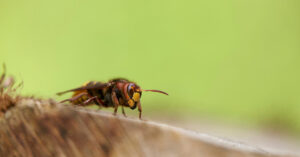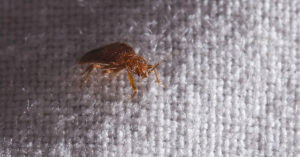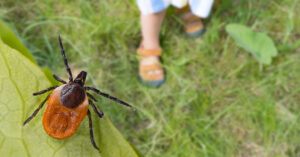 Bees and hornets may look similar at first glance. But they have some clear differences if you know what to look for. They have distinct physical characteristics, nesting locations, diets, aggression levels, and sting severity.
Bees and hornets may look similar at first glance. But they have some clear differences if you know what to look for. They have distinct physical characteristics, nesting locations, diets, aggression levels, and sting severity.
How to Identify a Carpenter Bee Hole
 It’s summertime, and suddenly there are a few mysterious holes in your siding, deck, or other wood areas of your home. You prod one of the holes and a little sawdust comes out. Then you see it… a dark, fuzzy bee that has been droning around the yard enters the hole. “What in the world is going on here?” you may wonder.
It’s summertime, and suddenly there are a few mysterious holes in your siding, deck, or other wood areas of your home. You prod one of the holes and a little sawdust comes out. Then you see it… a dark, fuzzy bee that has been droning around the yard enters the hole. “What in the world is going on here?” you may wonder.
If this has happened to you, there’s a good chance carpenter bees have taken up residence on your property. Carpenter bees are a member of the bee species that drill holes in wood to build their nests. Female carpenter bees use their powerful mandibles to bore into wood in a circular motion. This creates a round hole that over time is expanded into a maze of channels and chambers. These tunnels eventually weaken the wood and damage the integrity of the structure in which they’re built.
The Pros and Cons of Carpenter Ants
 When you think of carpenter ants, it’s entirely possible nothing positive comes to mind. But did you know they serve an important role in the ecosystem, and have some benefits for gardens as well? Carpenter ants are fascinating creatures…as long as they don’t come too close to your home or property.
When you think of carpenter ants, it’s entirely possible nothing positive comes to mind. But did you know they serve an important role in the ecosystem, and have some benefits for gardens as well? Carpenter ants are fascinating creatures…as long as they don’t come too close to your home or property.
Early Warning Signs of Bed Bugs
 When it comes to pest control, it’s wise to be proactive and nip a potential infestation in the bud. But what happens when you don’t realize you have pests until the problem has already spread throughout your home?
When it comes to pest control, it’s wise to be proactive and nip a potential infestation in the bud. But what happens when you don’t realize you have pests until the problem has already spread throughout your home?
One pest that may be multiplying stealthily while you remain blissfully unaware is the bed bug. June 4-10 is Bed Bug Awareness Week and, to mark this observance, we will share some tips on recognizing the early warning signs of bed bugs.
What Are the Signs of a Bed Bug Infestation?
Some early warning signs of bed bugs include:
- Live bed bugs are the surest sign of a budding infestation. Learn how to recognize them so you can take action before they spread.
- Bites on your arms, legs, or other areas of exposed skin may be due to bed bugs.
- Bloodstains on bedding or furniture that have no other explanation may be due to bed bug bites or crushed bed bugs.
- Bed bug casings, droppings, or eggs are easily identifiable and are signs that live bed bugs are present (even if you haven’t seen any yet).
- A musty odor that smells vaguely berry-like may be due to bed bugs. Once you can smell them, they have already infested your home.
Can You See Bed Bugs in the Early Stages?
In the early stages of a bed bug infestation, it may be easy to explain away the signs.
A rusty spot on your sheets could be blood from a blemish or small cut, small brown specks could be dirt tracked in by a pet, or itchy spots on your legs could be an allergic reaction to something you brushed against in the yard. If you know the signs and look closely though, bed bugs and their handiwork are visible – even before a full infestation occurs.
How Can You Tell If a Bed Bug is on You?
Adult bed bugs are small, but they’re visible to the naked eye. They are flat and oval-shaped, approximately 4 to 5 millimeters long. Bed bugs are brownish in color and turn reddish-brown after consuming a blood meal. They are wingless and can neither fly nor jump. Instead, they crawl from place to place and – if there is a bed bug on you – you should be able to feel it moving around.
Bed bug bites occur in groups, typically in a crooked line. They are red and itchy and may cause additional skin irritation in the area of the bites. Bites are typically found on the legs, arms, or any other area of exposed skin.
How Long Can You Have Bed Bugs Without Realizing It?
Because bed bugs are quite small (and don’t multiply rapidly at first), it’s possible to go several months without noticing their presence. If you see any signs of bed bugs or if you think you may have bed bugs in your home, there are some things you can do to confirm your suspicions.
How to check for bed bugs:
- Examine beds and bedding (including all crevices) for live bugs, casings, droppings, or eggs.
- Check other soft furnishings like couches, fabric chairs, and pet beds. Bed bugs seek warmth and will gravitate toward areas where you spend the most time.
- Check for evidence of bed bugs around baseboards and the perimeter of all rooms.
- If you want to be absolutely sure whether you have bed bugs, contact a professional exterminator. We are trained in bed bug detection and remediation… and can stop an infestation in its tracks and restore your peace of mind.
Call Twin Forks Pest Control® for Bed Bug Remediation
Twin Forks Pest Control® offers state-of-the-art bed bug detection and remediation. If you see signs of bed bugs in your home, call us for a free estimate.
What Pests Can Affect People With Asthma?
 May is National Asthma and Allergy Awareness Month. What does that have to do with everyday pests? Quite a bit.
May is National Asthma and Allergy Awareness Month. What does that have to do with everyday pests? Quite a bit.
Asthma is a respiratory condition where a person’s airways become inflamed, narrowed, swollen, and filled with mucus, making breathing difficult. Additional symptoms can include chest pain, wheezing, and coughing. Asthma often flares when an individual is exposed to allergens or environmental triggers to which they have a particular sensitivity. Did you know that some common household pests are among the top asthma triggers?
What to Know About Lyme Disease on Long Island
 Tick season has arrived on Long Island, and with it comes the risk of contracting a tick-borne illness. The most common – and possibly most dreaded – of these is Lyme disease, a bacterial infection transmitted through tick bites. Characterized by flu-like symptoms and a distinctive bullseye rash, Lyme disease can cause debilitating long-term health effects.
Tick season has arrived on Long Island, and with it comes the risk of contracting a tick-borne illness. The most common – and possibly most dreaded – of these is Lyme disease, a bacterial infection transmitted through tick bites. Characterized by flu-like symptoms and a distinctive bullseye rash, Lyme disease can cause debilitating long-term health effects.
Is There Lyme Disease on Long Island?
A Columbia University study estimates that 56 percent of ticks on Long Island are carrying Lyme disease. The Suffolk County Department of Health Services believes those percentages may be even higher in eastern Suffolk County, particularly along the north and south shores where Lyme-carrying black legged ticks (also known as deer ticks) are plentiful.
How Common Is Lyme Disease in NY?
Because many people with mild cases of Lyme disease are either unaware that they have been exposed or don’t seek medical treatment, it’s difficult to get exact figures of how prevalent Lyme disease is in the state. Suffolk County alone reports approximately 500 confirmed cases each year. Estimates of unreported cases are significantly higher.
Regardless, if you have been bitten by a tick then the chances are greater than 50/50 that it carries Lyme. After any tick bite, it’s important to identify the species that bit you and to watch for signs you may have been exposed.
How Serious Is Lyme Disease?
Lyme disease infections vary in severity. If treated early, they are typically cured with a two-to-four-week course of oral antibiotics. However, some individuals experience symptoms that linger for months after the initial infection.
Post-treatment Lyme disease syndrome is when pain, fatigue, and brain fog last for six months or more after treatment for a Lyme disease infection. The consequences may be even more serious for those whose initial infection goes untreated. These individuals may develop late-stage Lyme disease that leads to permanent neurological damage and lifelong health issues.
What Are the Early Signs of Lyme Disease?
Early signs of Lyme disease typically include swollen lymph nodes, fatigue, headache, joint and muscle pain, fever and chills, and a red bump at the site of the bite. Many people develop a bullseye-shaped rash around the bite.
What Are the Stages of Lyme Disease?
Lyme disease has three stages:
- Stage one is localized Lyme disease, where the bacteria remain near the bite and hasn’t spread throughout the body.
- Stage two is called early disseminated Lyme disease, when bacteria has begun to spread.
- Stage three, or late disseminated Lyme disease, occurs when the bacteria has spread throughout the body.
Most cases of stage one Lyme disease resolve within weeks when treated promptly with antibiotics. Outcomes become progressively worse further into stage two or three, and may take months or years to clear, often leaving permanent damage. This is why prompt, early intervention is important.
If you have any reason to believe you have been exposed to Lyme disease, consult your doctor immediately.
Twin Forks Pest Control® Offers Comprehensive Pest Management
Twin Forks Pest Control® is your Long Island pest management expert, keeping your home and property pest free since 1997. We offer comprehensive pest management packages to keep your home and property pest-free year-round. Call us today for a free estimate. We look forward to hearing from you!
- « Previous Page
- 1
- …
- 4
- 5
- 6
- 7
- 8
- …
- 15
- Next Page »


